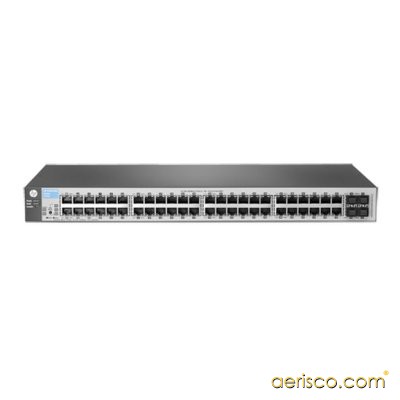The HP 1810-48G Switch is a Plug-and-Play, Web-Managed switch with 48 10/100/1000 copper ports and 4 non-shared SFP slots for optional fiber uplinks; ideal for small businesses, V1810-48G offers flexible mounting options and easy management.
HP 1810 switch series devices are basic smart managed fixed-configuration Gigabit Ethernet Layer 2 switches designed for small businesses looking for key features in an easy-to-administer solution. The series has three models: 8-, 24-, and 48-port 10/100/1000 switches. The 24-port model includes two dual-purpose combo SFP ports, and the 48-port model has four additional true Gigabit Ethernet SFP ports (52 total active ports) for fiber connectivity. All models support flexible deployment options, including mounting on walls or ceilings, under tables, or desktop operation, and come with an anti-theft protection Kensington Lock slot (lock not included). The 8-port model can optionally be powered by an upstream Power over Ethernet (PoE) switch. HP 1810 switches support QoS traffic prioritization and security features such as denial-of-service prevention. Customizable features include VLANs and link aggregation trunking. HP 1810 switches come with lifetime warranty.
Traffic prioritization (IEEE 802.1p): allows real-time traffic classification witheight priority levels mapped to four queues. Broadcast control: allows limitation of broadcast traffic rate to cut down on unwanted network broadcast traffic.
Simple Web management: intuitive Web GUI allows for easy management of device by even nontechnical users. Secure Web GUI: provides a secure, easy-to-use graphical interface for configuring the module via HTTPS. SNMPv1, v2c: devices can be discovered and monitored from an SNMP management station. Dual flash images: provide independent primary and secondary operating system files for backup while upgrading. Port mirroring: enables traffic on a port to be simultaneously sent to a network analyzer for monitoring.
Auto-MDI/MDIX: automatically adjusts for straight-through or crossover cables on all 10/100/1000 ports. Non-shared SFP ports (1810-48G switch): four true SFP ports for optional fiber connectivity such asGigabit-SX, -LX, or 100-FX; also support SFP 1G RJ-45 copper connections. Dual-personality ports (1810-24G switch): two Gigabit Ethernet copper ports or SFP slots for optional fiber connectivity such as Gigabit-SX and -LX, or 100-FX. IEEE 802.3af PoE-powered device option (1810-8G switch): can obtain power from a standard PoE device on Port 1, making the switch ideal for deployments where a power outlet is not available; such flexibility helps you to extend the network to wherever an Ethernet cable can reach. Packet storm protection: protects against broadcast, multicast, or unicast storms with user-defined thresholds.
Half-/Full-duplex auto-negotiating capability on every port: doubles the throughput of every port. Link aggregation (trunking): brings together groups of ports automatically using Link Aggregation Control Protocol (LACP), or manually, to form an ultra-high-bandwidth connection to the network backbone; helps prevent traffic bottlenecks; the 1810-8G switch has four trunks of four links each, the 1810-24G switch has eight trunks of four links each, and the 1810-48G switch has 16 trunks of eight links each. Fiber uplink: available on 24- and 48-port models; provides greater distance connectivity using Gigabit Ethernet fiber uplinks.
VLAN support and tagging: support up to 64 port-based VLANs and dynamic configuration of IEEE 802.1Q VLAN tagging, providing security between workgroups. Jumbo packet support: supports up to 9220-byte frame size to improve the performance of large data transfers.
Secure Sockets Layer (SSL): encrypts all HTTP traffic, allowing secure access to the browser-based management GUI in the switch. Automatic denial-of-service protection: monitors six types of malicious attacks and protects the network by blocking the attacks. Management password: provides security so that only authorized access to the Web browser interface is allowed.





